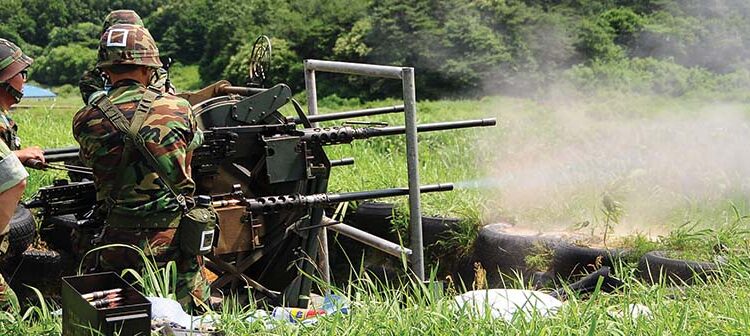By H.B. Hong
Usually, when a weapon system is in service for a long time, it typically undergoes upgrades, which usually enhance its performance. But here’s an exception; and you can see one, still, in ROK (Republic of Korea, or South Korea). In this case, a system has been downgraded. It has been used by the ROK army since the 1950s. With such a long service era, it’s quite strange that something has been downgraded rather than upgraded.
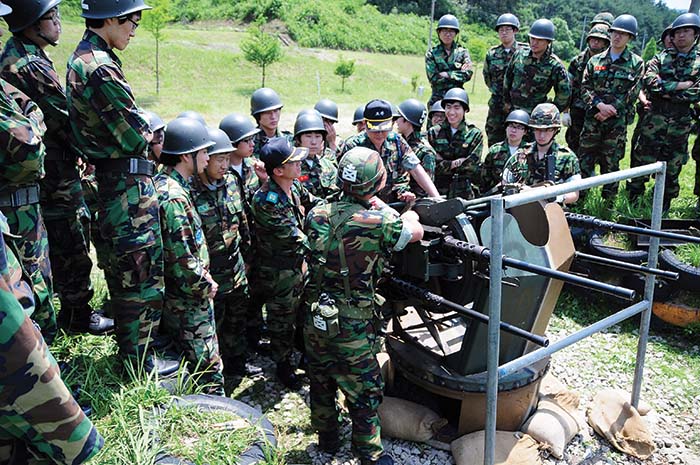
“Quad” and the Korean War
There are not too many SAR readers who do not know about the Quad mount for the .50 caliber Browning M2: the M45 Quad mount. It was a very effective weapon system for ground attack. Of course, it was an effective anti-aircraft weapon, but its role as an AA weapon was somewhat limited during its initial service in WW2. It was not its own fault – because of air dominance of the European theatre by allied air forces, its chance of firing against enemy aircraft was not that great. But against ground targets, especially large numbers of enemy personnel, it showed devastating effect. The Quad .50 could shoot almost 40 rounds per second, and those rounds are not just ordinary .30 caliber rounds but .50 caliber rounds.
Soon after WWII, it again showed its effectiveness but this time in Korea. Again, its chance to shoot a target in the sky was very slim, but it was very busy for shooting targets on the ground with targets being plenty of Chinese and North Korean soldiers and equipment.
During the Korean War, Chinese expeditionary forces used ‘human wave’ tactics to overwhelm UN forces’ defense. To counter this threat the U.S. military extensively used Quad mounts. Fire a few hundred rounds of devastating .50 caliber rounds within a few seconds and this literally threw ‘bullet waves’ to stop ‘human waves.’ So many Chinese were mowed down by many Quads that its nickname “The Meat Chopper” was well earned.
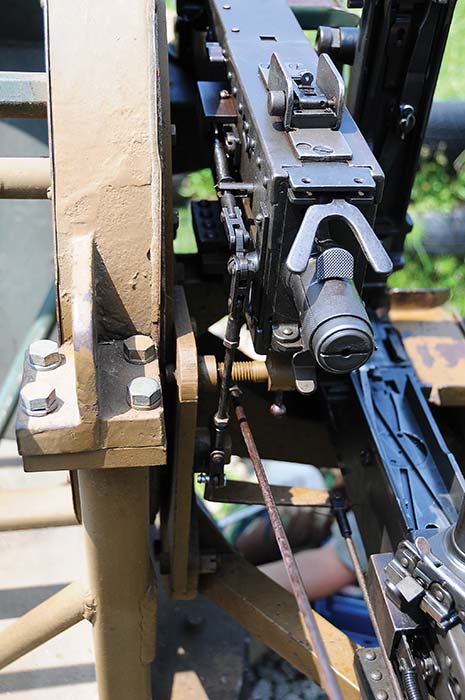
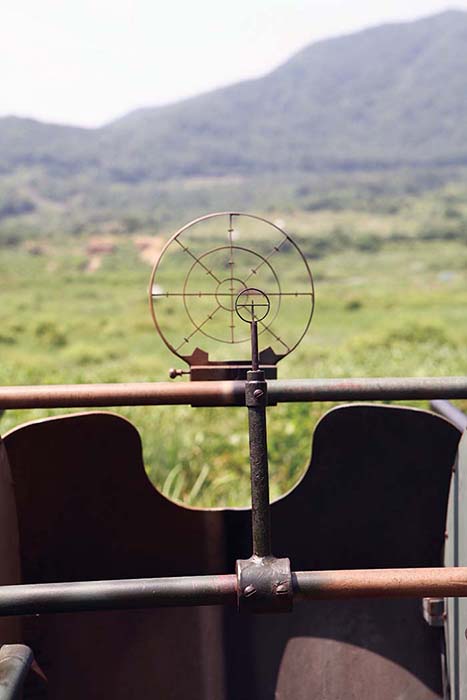
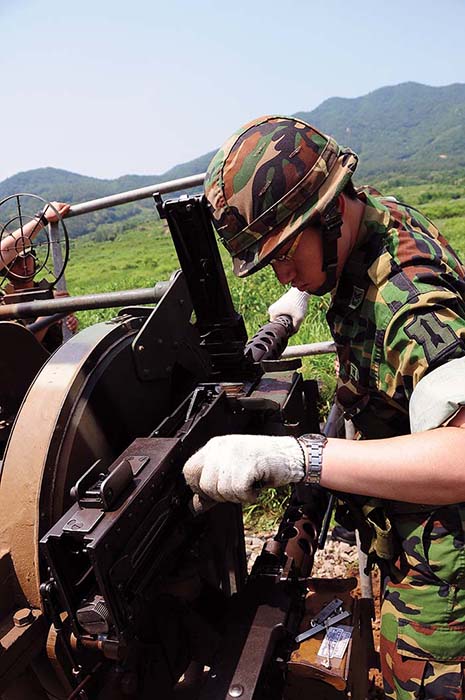
Service in Korean Military
After the Korean War, many Quad mounts were supplied to the ROK military by the U.S. and until the late 1970s they were very important low altitude AA systems in the ROK military. The ROK was a very poor country at that time, and if they had something supplied by the U.S. for free or at a very low price, they used it as extensively as possible, since those usually would be the only thing available for them. Since they received a considerable number of Quad mounts (including many M16A1 MGMC half tracks), they used them extensively and bought no other alternatives for a long time.
From the late 1970s, some of them were replaced by more modern weapon systems such as the VADS (Vulcan Air Defense System). The ROK began to make a license-built version of VADS and soon it became the mainstay of ROK’s air defense’s lowest ceiling.
But that didn’t mean the demise of Quad mounts in ROK service. While major AA outfits received VADS, many Quads were also retained and spread to countless areas for a local defense role.
One reason the ROK military didn’t throw away those old Quads, even during the 1980s and 90s, was the AN-2 Colt aircraft. The AN-2 is a Soviet-built biplane, which can fly very slow and very low; its slow speed and low altitude make it especially hard to be detected by radar, so North Koreans bought considerable numbers of them to infiltrate special forces against the ROK. Since Korea is quite mountainous, there are many routes where AN-2s can fly through. VADS are not cheap systems, so the number of them were not enough. Thus, many Quads were placed on scores of mountains or high grounds to cover those routes. AN-2s are not only slow and low-flying, but also quite vulnerable to small arms fire; it has no armor, and its wings are basically metal frames covered with canvas. Only a few rounds of .50 tracers can light this thing up, and once you can see AN-2s, it’s quite easy to hit them with Quads.
AN-2s were not the only concern. Since North Korea can muster considerable numbers of light infantry at many points, those Quads were also used to cover such threats – not much different from the role which it had done during the Korean War.
Another role was mobile defense. While the ROK army has considerable numbers of self-propelled Vulcans (K263; which is similar to U.S. made M163, but using Korean made K200 chassis instead of M113 APC Chassis), most of them are used with mechanized outfits, so some Quads were mounted on 2.5 ton trucks and used as mobile defense for important places like airfields, until the early 2000s.
The name of the Quads in the Korean army was Seung-Gong Po or Seung-Jeon Po. Seung-Gong Po means ‘a cannon to win against air threat,’ and Seung-Jeon Po means ‘Victorious cannon.’ But it seems both of them were not official nomenclature; officially it usually being called as ‘light cannon.’
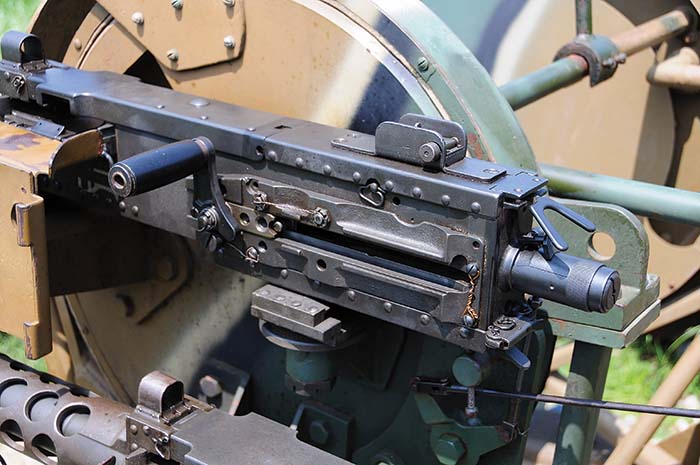
Not Retiring, But Downgrading
During the late 1990s to early 2000s, virtually all ROK Quads met their life’s end. While some parts were copied during the 70s and 80s, the military felt no need to buy important parts like motors or other power-related parts for the obsolete Quads. Also, the need for Quads become much less than previous years. The number of VADS or K263s now became considerable, and during 1990s to 2000s they bought large numbers of MANPADS (Man-portable air-defense systems, which means shoulder-fired anti-aircraft missiles like the famous Stinger) from France and Russia. From the late 2000s they even began to produce their own version of MANPADS. With new low-altitude radars to detect AN-2s, there seemed not much reason to place so many Quads on the northern side of ROK. So as an original form, M45 Quad mounts officially retired from ROK military in 2010.
But that doesn’t mean the ROK military, in this case the army, wanted to retire all of them; they still wanted to retain some number of them. Usually, most countries upgrade such old systems once they decided to retain them. The ROK did exactly the opposite. They just downgraded them. They stripped off most of the power related parts and removed most of the armored covers around it; and since there’s no power, the seat was also removed. They added a large handlebar on it and attached a bicycle-brake lookalike firing mechanism. Simply speaking, they changed electronically powered Quad mounts into manually operated Quad mounts in which the operator has to stand up and move it with his own muscle. Even before the official retirement of M45, many numbers of them were converted in that way. Of course, the optical sights originally provided were also removed and simple ring sights are now being used.
It’s a somewhat strange decision since most countries retained the M45 for a long time and usually upgraded them; mostly with 20mm cannons and new power system plus new sights. But the ROK army feel they already have considerable numbers of better weapons (like Vulcans and MANPANDS), and Quads are now being distributed more to rear or unimportant areas. The only two things Quads have to deal with now are AN-2s and enemy special forces (or light infantry). Both threats need no power traverse, since AN-2s are quite slow and infantry is much slower than that. Manually operated quads can still track and shoot them, and firepower is still great whether it’s moved by hand or electric motor. Cost-wise it would be quite economical while not as effective as it used to be.
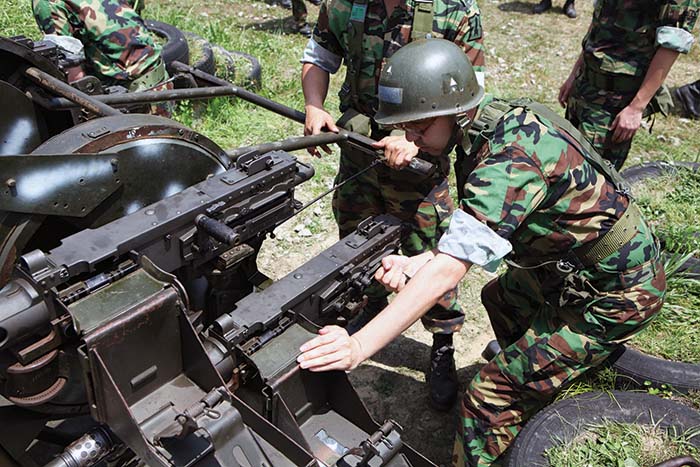
Training and Live Fire
The pictures for this article were taken during the summer of 2010. The place was southwestern part of ROK, where the North Korean threat would be quite less than those of northern areas.
Actually, especially in this area, most of ROK’s manual Quads are operated by reserve forces.
The ROK military’s reserve system needs a little explanation. Unlike other countries, like the U.S., virtually all active military servicemen automatically become reserve after they finish their active military service. Until 4 years after their service, they become ‘mobilized reserve’ which receive 5 days of training per year and would be drawn into active service when war occurs. After 4 years of mobilized reserve service, they now move into the local reserve, which needs 3 years of service and 36 hours of yearly training. These local reserves are not dispatched to active service even in wartime, but defend their hometown or workplace. Most obsolete firearms are being dispatched to those local reserves: for example, ROK army still retains large numbers of M1/M2 Carbines for them.
The place we visited was a training ground to fire support weapons like machine guns. On that day, some reserve soldiers, managed by the army’s 31st Division, had been doing live fire training with the manual Quads. The soldiers were local defense reserves assigned to ‘workplace reserve.’ They were part of the local reserve that literally defends their workplace during wartime. This could include the steel mill, car factory, machine factories or even nuclear power plants.
Some quads were placed at many such places in case of wartime enemy infiltration. It’s quite hard to expect the Quads will be well-maintained in such places. Maintaining the machine guns mounted on them are probably the best they can expect, so removing all power systems was the answer. With that, nothing would go wrong even with minimal maintenance (or virtually without it).
The guns mounted on them are of course the famous Ma Deuces. While the ROK regular army is using the K6, which is the ROK version of M2HB QCB (Quick Change Barrel), all M2s on Quads are regular M2HBs that were all supplied from U.S. and virtually all of them are WW2 vintage. Of course being Brownings, they need to be checked for headspace and timing during barrel change or maintenance. But virtually all reserve soldiers in that place didn’t know how to do that or even didn’t know what headspace or timing means. While some of them used .50 cals. during their active service, their gun was the K6, which requires no headspace adjustment, so it’s natural for them not knowing about that. They’re from a completely different generation. Such work was done by very experienced NCOs and warrant officers who are in active service and supporting those reserves as armorers. Thanks to them, while eight guns were used on that training day, all guns could fire with relative reliability, though there had been a few jams occurring.
Firing the weapon was easier than it seems. Most expected some very hard labor, and indeed it needed some physical strength, but it didn’t require untold strength to use. Also, because it is operated by two loaders, the shooter can have their help to operate the guns. Feeding is basically done by ordinary 100-round ammo cans. The famous ‘tombstone’ 200-round drum cans were long gone from ROK service, and even those old armorers don’t know about them. And for the live fire exercise here, they didn’t even use such ammo cans since ammo was limited. Only 20 to 28 rounds were fired per shooter, so belts were shortened to 5 to 7 round length and fed by hand.
Overall, it’s somewhat a bizarre weapon, and needless to say it’s far from adequate to modern standards. But since the ROK is still confronting an enemy who’s also far from modern standard, these ‘Victorious Cannons’ will stay in ROK service for the time being.
| This article first appeared in Small Arms Review V18N4 (August 2014) |



